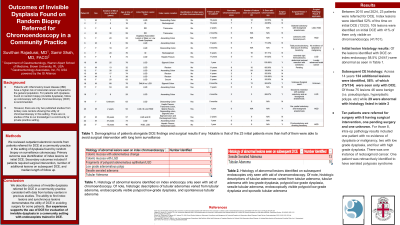Tuesday Poster Session
Category: IBD
P4297 - Outcomes of Invisible Dysplasia Found on Random Biopsy Referred for Chromoendoscopy in a Community Practice
Tuesday, October 29, 2024
10:30 AM - 4:00 PM ET
Location: Exhibit Hall E

Has Audio

Suvithan Rajadurai, MD
Brown Medicine/Lifespan
Providence, RI
Presenting Author(s)
Suvithan Rajadurai, MD1, Samir Shah, MD2
1Brown Medicine/Lifespan, Providence, RI; 2Gastroenterology Associates, Providence, RI
Introduction: Patients with inflammatory bowel disease (IBD) have a higher risk of colorectal cancer compared to the general population. For patients with dysplasia found on random biopsy (invisible dysplasia), followup colonoscopy with dye chromoendoscopy (DCE) is recommended. However, there are only two published studies involving tertiary care centers showing the utility of chromoendoscopy in this setting. There are no studies of this to our knowledge in a community private practice setting.
Methods: We reviewed outpatient electronic records from patients referred for DCE at a community practice in the setting of dysplasia found by random biopsy on surveillance colonoscopy. Primary outcome was identification of index lesions on initial DCE. Secondary outcomes included if patients required surgical intervention, number of additional lesions on subsequent DCE, and median length of follow up.
Results: Between 2010 and 2024, 23 patients were referred for DCE. Index lesions were identified 52% of the time on initial DCE (12/23). 101 lesions were identified on initial DCE with 75% of them only visible on chromoendoscopy (76/101). [Table 1] Histology demonstrated 31 cases of normal colonic mucosa, 15 pseudopolyps, 42 adenomas (sessile serrated or tubular), 9 hyperplastic polyps and 4 cases of polypoid low grade dysplasia. At a median 2 years of follow-up (range: 1 month - 12 years), 157 additional lesions were found, 55% of which only seen with DCE (87/157). On histology 16 lesions were normal colonic mucosa, 29 pseudopolyps, 53 hyperplastic polyps, 37 adenomas (sessile serrated or tubular), 17 cases of polypoid low grade dysplasia and 5 cases of polypoid high grade dysplasia. Ten patients were referred for surgery with 8 of them having undergone surgical intervention, one pending surgery and one unknown. For those 8, pathology results included one patient with no evidence of dysplasia or malignancy, two with low grade dysplasia, and four with high grade dysplasia. There was one instance of rectosigmoid cancer.
Discussion: We describe outcomes of invisible dysplasia referred for DCE in a community practice consistent with data from tertiary centers in previous studies. The ability to find index lesions and synchronous lesions demonstrates the utility of DCE in avoiding surgery for some patients. Our experience supports the use of DCE for evaluation of invisible dysplasia in a community setting with endoscopists trained in DCE.
Note: The table for this abstract can be viewed in the ePoster Gallery section of the ACG 2024 ePoster Site or in The American Journal of Gastroenterology's abstract supplement issue, both of which will be available starting October 27, 2024.
Disclosures:
Suvithan Rajadurai, MD1, Samir Shah, MD2. P4297 - Outcomes of Invisible Dysplasia Found on Random Biopsy Referred for Chromoendoscopy in a Community Practice, ACG 2024 Annual Scientific Meeting Abstracts. Philadelphia, PA: American College of Gastroenterology.
1Brown Medicine/Lifespan, Providence, RI; 2Gastroenterology Associates, Providence, RI
Introduction: Patients with inflammatory bowel disease (IBD) have a higher risk of colorectal cancer compared to the general population. For patients with dysplasia found on random biopsy (invisible dysplasia), followup colonoscopy with dye chromoendoscopy (DCE) is recommended. However, there are only two published studies involving tertiary care centers showing the utility of chromoendoscopy in this setting. There are no studies of this to our knowledge in a community private practice setting.
Methods: We reviewed outpatient electronic records from patients referred for DCE at a community practice in the setting of dysplasia found by random biopsy on surveillance colonoscopy. Primary outcome was identification of index lesions on initial DCE. Secondary outcomes included if patients required surgical intervention, number of additional lesions on subsequent DCE, and median length of follow up.
Results: Between 2010 and 2024, 23 patients were referred for DCE. Index lesions were identified 52% of the time on initial DCE (12/23). 101 lesions were identified on initial DCE with 75% of them only visible on chromoendoscopy (76/101). [Table 1] Histology demonstrated 31 cases of normal colonic mucosa, 15 pseudopolyps, 42 adenomas (sessile serrated or tubular), 9 hyperplastic polyps and 4 cases of polypoid low grade dysplasia. At a median 2 years of follow-up (range: 1 month - 12 years), 157 additional lesions were found, 55% of which only seen with DCE (87/157). On histology 16 lesions were normal colonic mucosa, 29 pseudopolyps, 53 hyperplastic polyps, 37 adenomas (sessile serrated or tubular), 17 cases of polypoid low grade dysplasia and 5 cases of polypoid high grade dysplasia. Ten patients were referred for surgery with 8 of them having undergone surgical intervention, one pending surgery and one unknown. For those 8, pathology results included one patient with no evidence of dysplasia or malignancy, two with low grade dysplasia, and four with high grade dysplasia. There was one instance of rectosigmoid cancer.
Discussion: We describe outcomes of invisible dysplasia referred for DCE in a community practice consistent with data from tertiary centers in previous studies. The ability to find index lesions and synchronous lesions demonstrates the utility of DCE in avoiding surgery for some patients. Our experience supports the use of DCE for evaluation of invisible dysplasia in a community setting with endoscopists trained in DCE.
Note: The table for this abstract can be viewed in the ePoster Gallery section of the ACG 2024 ePoster Site or in The American Journal of Gastroenterology's abstract supplement issue, both of which will be available starting October 27, 2024.
Disclosures:
Suvithan Rajadurai indicated no relevant financial relationships.
Samir Shah: Roche Information Systems – Consultant.
Suvithan Rajadurai, MD1, Samir Shah, MD2. P4297 - Outcomes of Invisible Dysplasia Found on Random Biopsy Referred for Chromoendoscopy in a Community Practice, ACG 2024 Annual Scientific Meeting Abstracts. Philadelphia, PA: American College of Gastroenterology.
